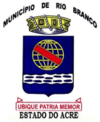Rio Branco, Acre
| Rio Branco | |||
|---|---|---|---|
| Municipality | |||
| The Municipality of Rio Branco | |||

Rio Branco, Top left:Maternidade Park, Top right:Mercado Velho (Old Market) theme park, Middle left:JK Bridge, Middle right:A walkway in Passarela Joaquim Macedu theme park, Bottom:Panorama view of Acre River and downtown Benjamin Constant area
|
|||
|
|||
| Nickname(s): "Capital da Natureza" (Capital of Nature) | |||
 Location of Rio Branco in the State of Acre |
|||
 |
|||
| Coordinates: 9°58′29″S 67°48′36″W / 9.97472°S 67.81000°WCoordinates: 9°58′29″S 67°48′36″W / 9.97472°S 67.81000°W | |||
| Country |
|
||
| Region | North | ||
| State |
|
||
| Founded | December 28, 1882 | ||
| Government | |||
| • Mayor | Marcus Alexandre (PT) | ||
| Area | |||
| • Total | 8,835.68 km2 (3,411.48 sq mi) | ||
| Elevation | 143 m (469 ft) | ||
| Population (2011) | |||
| • Total | 319,825 | ||
| • Density | 33.11/km2 (85.8/sq mi) | ||
| Time zone | UTC-5 (UTC-4) | ||
| Postal Code | 68900-000 | ||
| Area code(s) | (+55) 68 | ||
| Website | www |
||
Rio Branco (Portuguese pronunciation: [ˈʁiu ˈbɾɐ̃ku], White River) is a Brazilian municipality, capital of the state of Acre. Located in the valley of the Acre River in northern Brazil, it is the most populous municipality in the state, with 319,825 inhabitants – almost half the state population, according to the 2011 census.
Rio Branco was one of the first settlements to appear on the banks of the Acre River. In 1913 it became a county. In 1920 it became the capital of the territory of Acre, and in 1962, the state capital. It is the administrative center for the economic and cultural region.
Rio Branco is located at 9° 58' 29" south and 67° 48' 36" west, at an altitude of 143 metres (469 ft) above sea level. The city is bisected by the Acre River, which divides it into the First and Second Districts. The river is crossed by six bridges, the newest bridge being the Catwalk Joaquim Macedo.
Rio Branco is located in the mesoregion of Vale do Jurua and the microregion of Rio Branco. It is bordered on the north by the municipalities of Bujari and Porto Acre; to the south by the municipalities of Xapuri, Capixaba, and Plácido de Castro; to the east by the municipality of Senador Guiomard; and to the west by the municipality of Sena Madureira.
The Amazon rainforest represents over half of the planet's remaining rainforests and comprises the largest and most species-rich tract of tropical rainforest in the world. Wet tropical forests are the most species-rich biome, and tropical forests in the Americas are consistently more species rich than the wet forests in Africa and Asia. As the largest tract of tropical rain forest in the world, the Amazonian rainforests have unparalleled biodiversity. More than one-third of all species in the world live in the Amazon rainforest.
...
Wikipedia


